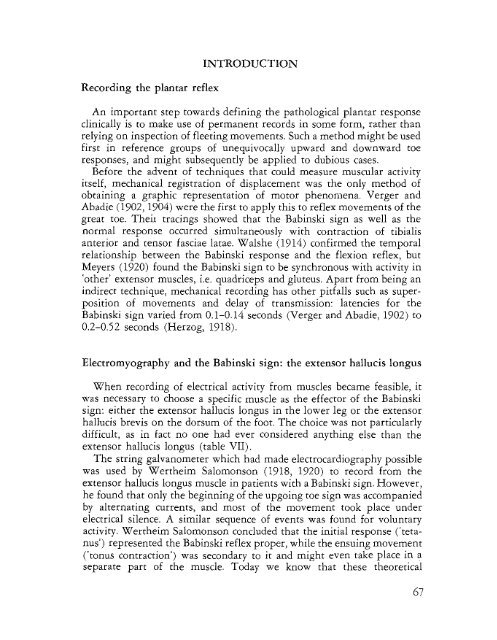Create successful ePaper yourself
Turn your PDF publications into a flip-book with our unique Google optimized e-Paper software.
Recording the plantar reflex<br />
INTRODUCTION<br />
An important step towards defining the pathological plantar response<br />
clinically is to make use of permanent records in some form, rather than<br />
relying on inspection of fleeting movements. Such a method might be used<br />
first in reference groups of unequivocally upward and downward toe<br />
responses, and might subsequently be applied to dubious cases.<br />
Before the advent of techniques that could measure muscular activity<br />
itself, mechanical registration of displacement was the only method of<br />
obtaining a graphic representation of motor phenomena. Verger and<br />
Abadie (1902, 1904) were the first to apply this to reflex movements of the<br />
great toe. Theit tracings showed that the Babinski sign as well as the<br />
normal response occurred simultaneously with contraction of tibialis<br />
anterior and tensor fasciae latae. Walshe (1914) confirmed the temporal<br />
relationship between the Babinski response and the flexion reflex, but<br />
Meyers (1920) found the Babinski sign to be synchronous with activity in<br />
'other' extensor muscles, i.e. quadriceps and gluteus. Apart from being an<br />
indirect technique, mechanical recording has other pitfalls such as superposition<br />
of movements and delay of transmission: latencies for the<br />
Babinski sign varied from 0.1-0.14 seconds (Verger and Abadie, 1902) to<br />
0.2-0.52 seconds (Herzog, 1918).<br />
Electromyography and the Babinski sign: the extensor hallucis longus<br />
When recording of electrical activity from muscles became feasible, it<br />
was necessary to choose a specific muscle as the effector of the Babinski<br />
sign: either the extensor hallucis longus in the lower leg or the extensor<br />
hallucis brevis on the dorsum of the foot. The choice was not particularly<br />
difficult, as in fact no one had ever considered anything else than the<br />
extensor hallucis longus (table VII).<br />
The string galvanometer which had made electrocardiography possible<br />
was used by Wertheim Salomonson (1918, 1920) to record from the<br />
extensor hallucis longus muscle in patients with a Babinski sign. However,<br />
he found that only the beginning of the upgoing toe sign was accompanied<br />
by alternating currents, and most of the movement took place under<br />
electrical silence. A similar sequence of events was found for voluntary<br />
activity. Wertheim Salomonson concluded that the initial response ('tetanus')<br />
represented the Babinski reflex proper, while the ensuing movement<br />
('tonus contraction') was secondary to it and might even take place in a<br />
separate part of the muscle. Today we know that these theoretical<br />
67
















